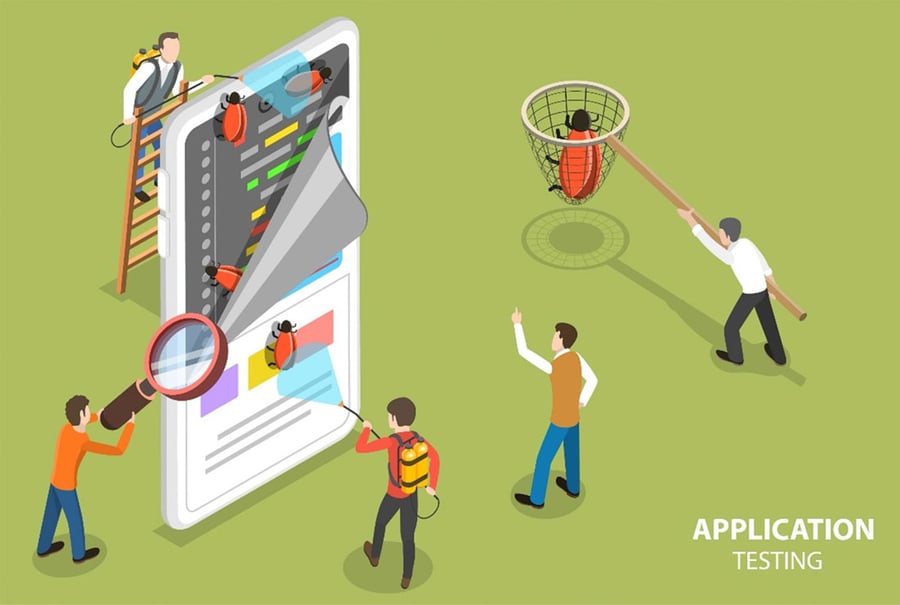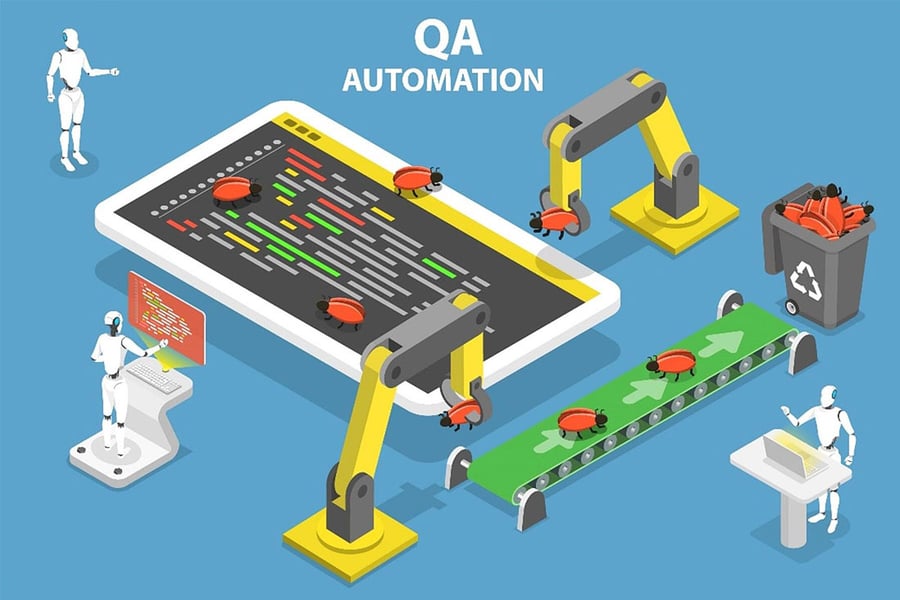
Software testing is a crucial part of the app development life cycle. There is no way an application can be rolled out to the end-users without thoroughly testing all of its features and functionalities. As important as QA testing is, it is also undeniable that it is extremely repetitive and time-consuming. Manual testing procedures require teams to develop multiple test cases to test every minute feature of the application. Every time a bug is found, it is recorded and reported to the developers to fix the errors. Once fixed, the process starts again and continues until all the features of the application are defect-free. This takes enormous amounts of time.
Managing the testing process is also very cumbersome as it demands planning, bug tracking, and reliability analysis. Additionally, as everything is manually tracked and tested, there is a huge margin for errors. Small bugs and defects will slip through the cracks and end up in the final version of the application. This final application with all its defects will reach the end-users and eventually damage brand value and reliability.
To avoid all these discrepancies of manual testing, QA teams aim to automate their testing processes. Automation testing automates the routine testing operations with testing tools and makes the development process faster, cheaper as well efficient.
What is Test Automation Frameworks?
A Test Automation Framework is a set of guidelines, like coding standards, data handling, object repository treatment, etc incorporated with a set of testing tools to automate the process of quality testing of any application. With an automation framework in place, the process of testing is streamlined and organized, less time-consuming, and more efficient. Additionally, there are also benefits like increased code re-usage, higher portability, reduced script maintenance cost.
In short, a test automation framework collection of specific components that facilitate application testing. It also enables teams to implement a comprehensive reporting system for test results. The components that implement a test automation framework successfully are testing tools, scripts, processes and procedures, and a team of test automation engineers.
Benefits of Test Automation Framework
The main aim of using testing automation frameworks is to increase the speed and efficiency of the testing process. It helps improve the accuracy of tests and reduces risk, which altogether helps reduce the costs of application testing and maintenance. Apart from this testing frameworks help bring order to the chaotic testing process.
- Minimizes manual intervention
- Maximizes test coverage
- Creates reusable code
- Provides a structured testing methodology and ensures uniformity across multiple test scripts
- Reduces dependency on individual test-cases
- Increases reliability in the issue and bug detection process
- Delivers root-cause analysis with minimum human intervention
- Reduces team dependence by automatically executing tests based on test scenarios
- Dynamically restructures test scopes to align with the changes in the test strategy or conditions of the system under test
- Ensures an uninterrupted and automated testing process with little human intervention
Types of Test Automation Frameworks
There are 6 different types of test automation frameworks that test engineers can choose from to automate their testing processes. Each has its own benefits and drawbacks. So, test engineers usually choose the right one that best fits their requirements.
- Linear Automation Framework
- Modular Driven Automation Framework
- Behaviour Driven Testing Framework
- Data-Driven Testing Framework
- Keyword-Driven Automation Framework
- Hybrid Testing Framework
Linear Automation Framework
This framework is usually used for testing small applications. It is based on the concept of record and playback mode aligned linearly. In this framework, the creation and execution of test scripts are done individually. It is an ideal framework for testing small applications as there are fewer repetitive iterations in test sets. One does not need to write custom code specifically for automation purposes and there is a negligible learning curve for the teams. This framework is also commonly known as the record and playback framework.
Modular Driven Automation Framework
The modular-driven framework is built on the concept of abstraction. The application is first broken down into smaller modules. Each module and its dependencies are determined and then are tested separately. An abstraction layer is built for the components that are hidden from the application during testing. This framework ensures the division of scripts and lets QA engineers write independent test scripts for separate modules. This leads to easier maintenance and scalability.
Behaviour Driven Testing Framework
The behavior-driven framework is focused on system behavior. For this framework, a series of automated unit tests are run to separate the software design from its dependencies. This framework simplifies the testing process and enables all teams including developers and business analysts, to participate actively in the process. It also helps increase collaboration between QA engineers and developers on the project. In order to work with this framework, the QA team requires to have in-depth technical skills as well as sufficient experience.
Data-Driven Testing Framework
The data-driven testing framework, as the name goes, is data-oriented. In this testing framework, there is a separate tabular format file that is used to store all the input values and the expected output results. The driver script is the most important component of this framework. It contains the navigational path that spreads through the program and reads all the data files and logs the test status information. A single driver script can execute all the test cases with multiple sets of data. To implement this framework, a highly experienced tester who is proficient in various programming languages is required.
Keyword-Driven Automation Framework
The keyword-driven testing framework is application-independent. Irrespective of the type of application it is implemented on, it uses data tables and keywords to determine the actions to be performed on the application. It is also known as table-driven testing. The automation test scripts performed are based on the keywords specified in an excel sheet created for the project. This framework is suitable only for small projects or applications.
Hybrid Testing Framework
The hybrid framework is a combination of modular, data-driven, and keyword test automation frameworks. It combines the benefits of all these 3 frameworks. It involves more efforts for automation but the results are efficient. This is an ideal framework for a large-scale application with many features and modules.
Automating your QA Testing Processes
 All these frameworks help QA engineers test applications more efficiently. To get started with the automation, QA engineers need to start with a plan. There are a few straightforward steps to follow to get the right kick-start with automating the testing process.
All these frameworks help QA engineers test applications more efficiently. To get started with the automation, QA engineers need to start with a plan. There are a few straightforward steps to follow to get the right kick-start with automating the testing process.
- Evaluate your team capabilities and the application to figure out the gaps in the testing process that automation can bridge
- Define the goals and priorities to be achieved by implementing an automation framework
- Based on the team capabilities and the application size and complicatedness plan an automated testing strategy
- Based on the project requirements, select the right automation testing tools and the testing framework
- Pick your battles right - decide which test cases need to be automated
- Build your test data repository
- Design automated tests that are resistant to most UI changes so that you do not have to redo the test after every UI upgrade
- Execute the tests for the test scripts developed and start testing your application at an early stage
- Implement a continuous integration and continuous delivery (CI/CD) pipeline for testing
- Ensure that all the test scripts are preserved for future use
Takeaway
Automating your QA frameworks will bring a lot of stability to your end products in fewer iterations. Your Go-to-Market time will reduce and you will spend fewer resources on your applications. But, before embarking on a journey to automate your QA testing, ensure that you choose the right automation framework. Keep in mind your team capabilities and skills and the application size and complexity while deciding which framework is best suited for you.
Here at Innominds, we see automation as a hallmark of human ability. We embrace it. Our end-to-end quality engineering services are extremely efficient and tailored to help you through your QA automation journey.
iHarmonyTM - Innominds Test Automation Accelerator
iHarmonyTM, a strong next-generation testing platform designed by Innominds Quality Engineering specialists to drive efficiency and quality, solves the testing difficulties faced by organizations and shapes their digital future. iHarmonyTM provides testing services for a variety of industries, digital technologies, and applications. The testing platform is a strong solution created using industry best practices and procedures, integrating open source and commercial tools to offer test automation for web, mobile, and APIs.
iHarmonyTM was created to stay up with the fast pace of innovation by tackling obstacles and adopting best practices learned from our experience servicing clients. It was created to meet today's demand for digital disruption. The cutting-edge testing platform not only lowers delivery costs and cycle times but also enhances customer satisfaction.
How We've Aided Companies Just Like Yours
Client: A large security products company in the U.S.
End-to-end automation using dynamic data, numerous platforms of a web-based application dealing with Windows components, and connections to large databases and Linux computers were among the customer's challenges. Everything will be put to the test at the same time.
Innominds' automation experts devised a comprehensive solution that could manage all web components, including Windows, Linux, and databases, and built a solid foundation on top of the existing one to meet all end-to-end execution requirements on various virtual machines.
Then there were the advantages. The client was able to save regression testing time and effort by 80% each cycle, achieve over 70% Test Automation coverage, and execute Test Automation across many platforms and browsers.
Download the case study to know how Innominds meet a client’s testing requirements for Enterprise Security, IT Service Intelligence, Stream, and DB Connect.



